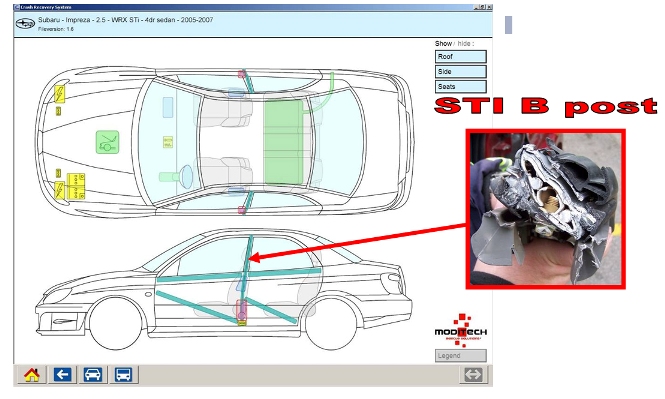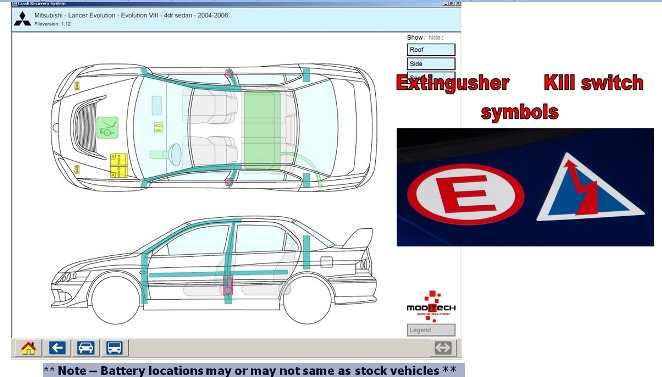By David Dalrymple
Even though a rally car transits on “normal” roadways and is technically a registered street vehicle, it is a highly modified race vehicle with hazards all its own. This sheet is designed as an orientation guide to look for hazards that might be found on arrival. There will be a variety of classifications of vehicle depending on two- or four-wheel drive, engine displacement, and so on. All vehicles will have two crew members, a driver, and a co-driver (navigator). It is critical to not respond until instructed to do so by net control after they ensure the cars have stopped racing on stage.


(1, 2) Rally and rallycross cars are stock production vehicles with safety cell (cages) and racing seats added. Drivetrains can run from conventional fuels, gas, and diesel to alternative fuels hybrids, E85, and bio diesel. SRS air bags are removed for obvious safety considerations. However, depending on the vehicle class, the 12v battery can be in the stock location or relocated.
First, Always Be Situationally Aware!
On arrival, carefully observe the scene. Is the crew out of the vehicle? Are they displaying a red cross or an “OK” page from their route book? Remember, a crew displaying a red cross means one or both of them are injured; keep one point person watching the stage from the direction that the cars are coming and remember that they are spaced approximately one minute apart, although that spacing can vary.
Second, Secure the vehicle!
Think WEST:
- Take down Window nets / roll down Windows.
- Shut down Electric system (battery).
- Secure vehicle (triangles).
- Turn off Toggle switches.
Most crews, if uninjured, will have already done these tasks; just ensure that they have been done.
- Medical. Assess just like any other patient from a motor vehicle collision. However, pay strict attention to damage inside and outside of the vehicle. Look at the seat and the safety cage; are they damaged? Are the seat belts damaged, frayed, or stretched? Are the helmet and HANS device damaged? What exterior damage is present? What did the vehicle strike?
- Firematics. Remember, most of these vehicles will be running racing gasoline, which will have ethanol in it. However, you may encounter rally cars with other motive power including diesel fuel and hybrid power. Besides fuel, there are other flammable items including vehicle construction materials, engine fluids and even suspension fluids. Be alert for flare-ups from dripping fluids onto hot turbos and exhausts.
- Rescue Services. Even though these are “stock” bodied vehicles, they also have a safety cage and lexan windows, while some models have ultra-high-strength reinforcements in their body structure. Stabilization might be a problem, depending on how and where the vehicle ends up. The seats for the crew are structurally strong and extremely form fitting, with side wings and bolstering that might need to be removed. You may need to assist crew with self extrication because of entangling cables and lines. Because of these issues, power hydraulic cutters and reciprocating saws will have a greater importance than spreading tools. If disentanglement is needed, be aware that these vehicles might be a difficult challenge depending on the tools at hand.
DAVID DALRYMPLE is a career EMS provider for the RWJUH Emergency Medical Services in New Brunswick, New Jersey, and a volunteer firefighter/EMT/rescue technician for Clinton (NJ) EMS/Rescue. He has been actively involved with emergency services for 27 years. He is the education chair of the Transportation Emergency Rescue Committee-US (TERC), is a certified international level extrication assessor, and serves on the Expert Technical Advisory Board of the IETRI as their road traffic accident advisor. Certified as a NJ fire service instructor, he has been teaching transportation rescue topics for more than 16 years. He is the executive educator for Roadway Rescue LLC, an educational team for transportation rescue training. He is an ICET (Netherlands) certified registered International SAVER instructor. He writes on “Extrication Tactics” for Fire Engineering and contributed to Fire Engineering‘s Handbook for Firefighter I and II (2009). He received the 2007 Harvey Grant award for excellence in rescue education. He is featured in “Training Minutes” on vehicle extrication on fireengineering.com.

